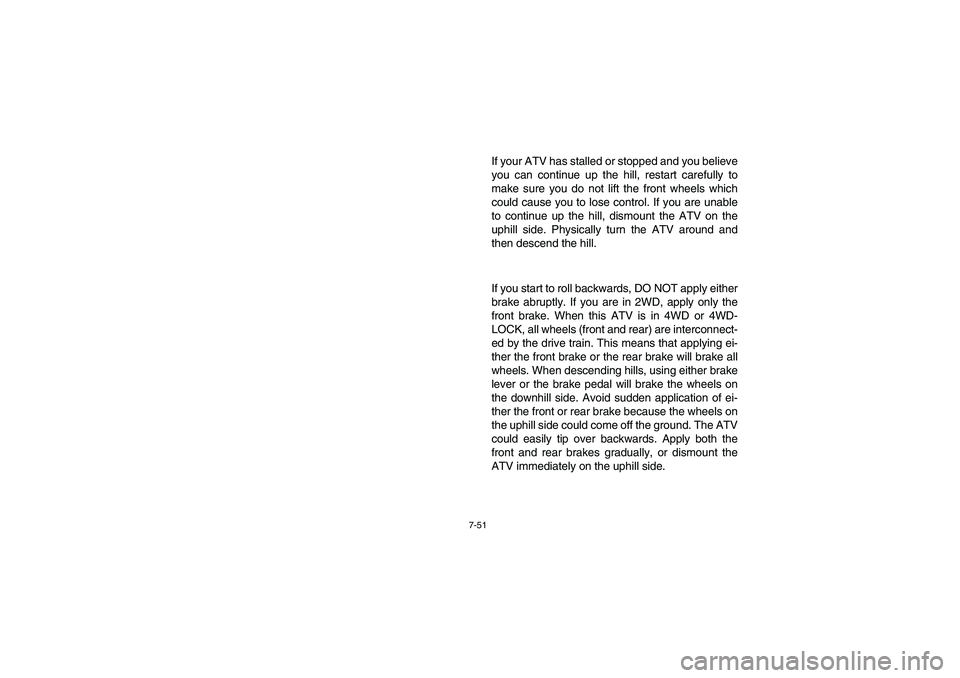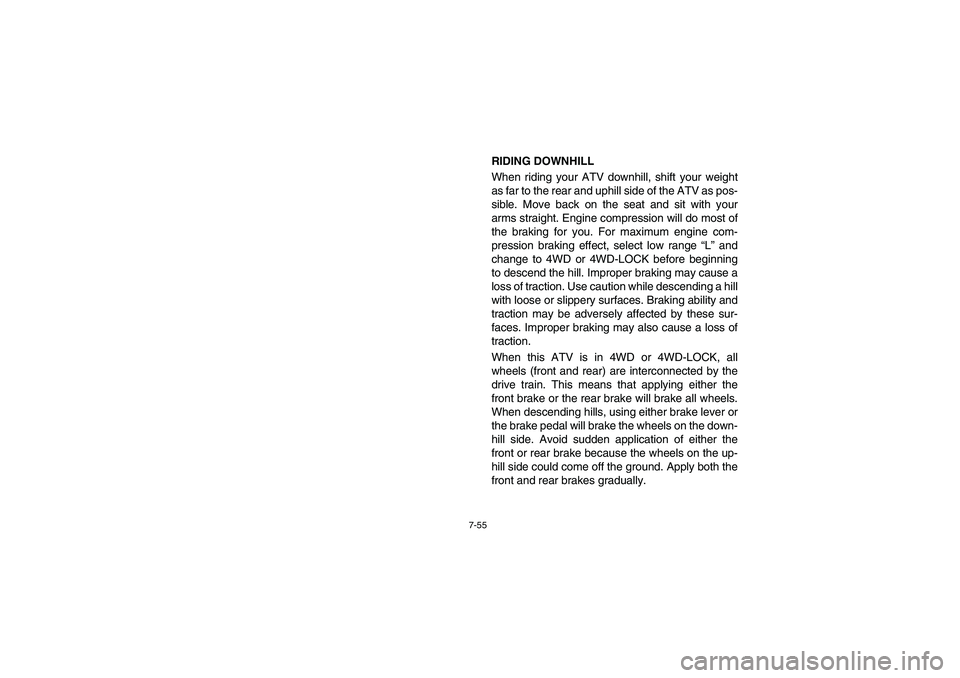Page 236 of 444

7-51
If your ATV has stalled or stopped and you believe
you can continue up the hill, restart carefully to
make sure you do not lift the front wheels which
could cause you to lose control. If you are unable
to continue up the hill, dismount the ATV on the
uphill side. Physically turn the ATV around and
then descend the hill.
If you start to roll backwards, DO NOT apply either
brake abruptly. If you are in 2WD, apply only the
front brake. When this ATV is in 4WD or 4WD-
LOCK, all wheels (front and rear) are interconnect-
ed by the drive train. This means that applying ei-
ther the front brake or the rear brake will brake all
wheels. When descending hills, using either brake
lever or the brake pedal will brake the wheels on
the downhill side. Avoid sudden application of ei-
ther the front or rear brake because the wheels on
the uphill side could come off the ground. The ATV
could easily tip over backwards. Apply both the
front and rear brakes gradually, or dismount the
ATV immediately on the uphill side.
U5KM61.book Page 51 Friday, July 26, 2002 11:13 AM
Page 240 of 444

7-55
RIDING DOWNHILL
When riding your ATV downhill, shift your weight
as far to the rear and uphill side of the ATV as pos-
sible. Move back on the seat and sit with your
arms straight. Engine compression will do most of
the braking for you. For maximum engine com-
pression braking effect, select low range “L” and
change to 4WD or 4WD-LOCK before beginning
to descend the hill. Improper braking may cause a
loss of traction. Use caution while descending a hill
with loose or slippery surfaces. Braking ability and
traction may be adversely affected by these sur-
faces. Improper braking may also cause a loss of
traction.
When this ATV is in 4WD or 4WD-LOCK, all
wheels (front and rear) are interconnected by the
drive train. This means that applying either the
front brake or the rear brake will brake all wheels.
When descending hills, using either brake lever or
the brake pedal will brake the wheels on the down-
hill side. Avoid sudden application of either the
front or rear brake because the wheels on the up-
hill side could come off the ground. Apply both the
front and rear brakes gradually.
U5KM61.book Page 55 Friday, July 26, 2002 11:13 AM
Page 244 of 444
7-59
CROSSING A SLOPE
Traversing a sloping surface on your ATV requires
you to properly position your weight to maintain
proper balance. Be sure that you have learned the
basic riding skills on flat ground before attempting
to cross a sloping surface. Avoid slopes with slip-
pery surfaces or rough terrain that may upset your
balance.
As you travel across a slope, lean your body in the
uphill direction. It may be necessary to correct the
steering when riding on loose surfaces by pointing
the front wheels slightly uphill. When riding on
slopes be sure not to make sharp turns either up or
down hill.
U5KM61.book Page 59 Friday, July 26, 2002 11:13 AM
Page 256 of 444
7-71
SLIDING AND SKIDDING
Care should be used when riding on loose or slip-
pery surfaces since the ATV may slide. If unex-
pected and uncorrected, sliding could lead to an
accident.
To reduce the tendency for the front wheels to
slide in loose or slippery conditions, positioning
your weight over the front wheels will sometimes
help.
If the rear wheels of your ATV start to slide side-
ways, control can usually be regained (if there is
room to do so) by steering in the direction of the
slide. Applying the brakes or accelerating is not
recommended until you have corrected the slide.
U5KM61.book Page 71 Friday, July 26, 2002 11:13 AM
Page 260 of 444
7-75
WHAT TO DO IF ...
This section is designed to be a reference guide
only. Be sure to read each section on riding tech-
niques completely.
WHAT TO DO ... �
If your ATV doesn’t turn when you want it to:
Bring the ATV to a stop and practice the turning
maneuvers again. Be sure you are putting your
weight on the footboard to the outside of the
turn. Position your weight over the front wheels
for better control. (See pages 7-39–7-43.)
�
If your ATV begins to tip while turning:
Lean more into the turn to regain balance. If nec-
essary, gradually let off the throttle and/or steer to
the outside of the turn. (See pages 7-39–7-43.)
�
If your ATV starts to slide sideways:
Steer in the direction of the slide if you have the
room. Applying the brakes or accelerating is
not recommended until you have corrected the
slide. (See pages 7-71–7-73.)
U5KM61.book Page 75 Friday, July 26, 2002 11:13 AM
Page 273 of 444

8-8
* It is recommended that these items be serviced by a Yamaha dealer.
** Lithium-soap-based greaseNOTE:Recommended brake fluid: DOT 4
Brake fluid replacement:
1. When disassembling the master cylinder or caliper cylinder, replace the brake fluid. Normally check
the brake fluid level and add fluid as required.
2. On the inner parts of the master cylinder and caliper cylinder, replace the oil seals every two years.
3. Replace the brake hoses every four years, or if cracked or damaged.Wheels*•Check balance/damage/runout.
•Repair if necessary.Wheel bearing*•Check bearing assemblies for looseness/damage.
•Replace if damaged.Front and rear
suspension*•Check operation.
•Correct if necessary.Steering system*•Check operation/Replace if damaged.
•Check toe-in/Adjust if necessary.Rear upper and lower
knuckle pivots*•Lubricate.**Drive shaft universal
joint*•Lubricate.**Engine mount*
•Check for cracks or damage.Front and rear axle boots*•Check operation.
•Replace if damaged.Stabilizer bushes*
•Check for cracks or damage.Fittings and Fasteners*•Check all chassis fittings and fasteners.
•Correct if necessary.
ITEM ROUTINEWhichever
comes firstINITIAL EVERY
km 320 1,200 2,400 2,400 4,800
hours 20 75 150 150 300
U5KM61.book Page 8 Friday, July 26, 2002 11:13 AM
Page 358 of 444
8-93 1. Brake pad a. Wear limit: 1 mm
1. Plaquette de frein a. Limite d’usure: 1 mm
1. Pastilla del freno a. Límite de desgaste: 1 mm
1. Brake pad 2. Brake pad plate
a. Wear limit: 1 mm
1. Plaquette de frein 2. Support de plaquette de frein
a. Limite d’usure: 1 mm
1. Pastilla del freno 2. Placa de la pastilla del freno
a. Límite de desgaste: 1 mm
EBU00312
Front brake pad inspection
Inspect the brake pads for damage and wear. If
the thickness is less than the specified value, have
a Yamaha dealer replace the pads.NOTE:The wheels need to be removed to inspect the
brake pads. See page 8-115 for removal proce-
dures.
EBU00878
Rear brake pad inspection
Inspect the brake pads for damage and wear. If
the thickness is less than the specified value, have
a Yamaha dealer replace the pads.
U5KM61.book Page 93 Friday, July 26, 2002 11:13 AM
Page 380 of 444
8-115 1. Tapered nut (× 4)
1.Écrou conique (× 4)
1. Tuerca cónica (× 4)
EBU01112
Wheel removal
1. Loosen the wheel nuts.
2. Elevate the ATV and place a suitable stand
under the frame.
3. Remove the nuts from the wheel.
4. Remove the wheel.
U5KM61.book Page 115 Friday, July 26, 2002 11:13 AM